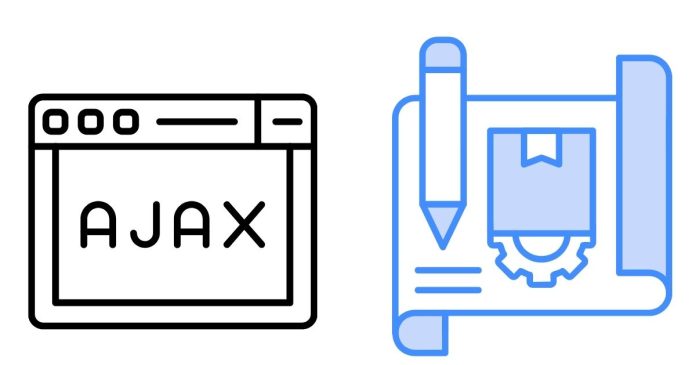In today’s web development landscape, creating dynamic and interactive web pages is crucial to providing a seamless user experience. One powerful combination for achieving this is Java and AJAX (Asynchronous JavaScript and XML). AJAX allows web pages to update content without reloading the entire page, making applications faster and more responsive. In this blog post, we’ll walk through an example of how to integrate Java with AJAX to create a dynamic, responsive web application.
What is AJAX?
AJAX (Asynchronous JavaScript and XML) is a set of web development techniques that allows web pages to communicate with the server in the background without refreshing the entire page. This means that only a part of the page can be updated, which results in a smoother and more efficient user experience.
AJAX uses JavaScript to send and retrieve data asynchronously from the server using the XMLHttpRequest object. While it traditionally worked with XML, it now commonly uses JSON due to its lighter weight and ease of use.
Why Use Java with AJAX?
Java is often used on the server-side of web applications to handle business logic, interact with databases, and return responses. By combining Java with AJAX, you can build dynamic web applications that have the following benefits:
- Improved user experience: No page reloads mean faster, more fluid interaction.
- Reduced server load: Only necessary data is sent and received, rather than reloading the entire page.
- Seamless communication: Java can process backend operations (like querying databases) and send data to the frontend asynchronously using AJAX.
Example: Java + AJAX
Let’s build a simple application where a user can input their name, click a button, and receive a personalized greeting without refreshing the page. The backend will be powered by Java (using a servlet), and the frontend will use AJAX to fetch the data.
Step 1: Create the Java Servlet (Server-Side)
First, we need to create a Java servlet that will handle the AJAX request and return a personalized greeting.
GreetingServlet.java
import javax.servlet.*;
import javax.servlet.http.*;
import java.io.*;
public class GreetingServlet extends HttpServlet {
protected void doGet(HttpServletRequest request, HttpServletResponse response) throws ServletException, IOException {
// Get the 'name' parameter sent by AJAX
String name = request.getParameter("name");
// Set the response type to plain text (or JSON if required)
response.setContentType("text/plain");
// Send the greeting as a response
PrintWriter out = response.getWriter();
if (name != null && !name.isEmpty()) {
out.println("Hello, " + name + "!");
} else {
out.println("Hello, Guest!");
}
}
}
In this servlet:
- We handle the GET request coming from the AJAX call.
- The servlet retrieves the
nameparameter from the request. - It then sends back a simple greeting message using
PrintWriter.
Step 2: Configure the Web Deployment Descriptor
In the web.xml file, we need to map the servlet to a URL pattern. This will allow the frontend to call the servlet via the AJAX request.
web.xml
<web-app xmlns="http://java.sun.com/xml/ns/javaee" xmlns:xsi="http://www.w3.org/2001/XMLSchema-instance" xsi:schemaLocation="http://java.sun.com/xml/ns/javaee http://java.sun.com/xml/ns/javaee/web-app_3_0.xsd" version="3.0">
<servlet>
<servlet-name>GreetingServlet</servlet-name>
<servlet-class>GreetingServlet</servlet-class>
</servlet>
<servlet-mapping>
<servlet-name>GreetingServlet</servlet-name>
<url-pattern>/greet</url-pattern>
</servlet-mapping>
</web-app>
This XML configuration ensures that when the user accesses the /greet URL, the GreetingServlet is triggered.
Step 3: Frontend with AJAX (Client-Side)
Now, let’s create the frontend using HTML and JavaScript (AJAX). We’ll provide a simple form where the user can input their name, and when they click the button, an AJAX request is made to the server to get the greeting.
index.html
<!DOCTYPE html>
<html lang="en">
<head>
<meta charset="UTF-8">
<meta name="viewport" content="width=device-width, initial-scale=1.0">
<title>Java AJAX Example</title>
<script type="text/javascript">
// Function to send AJAX request
function getGreeting() {
var name = document.getElementById("name").value; // Get the value entered by the user
var xhr = new XMLHttpRequest(); // Create a new XMLHttpRequest object
// Set up the request (GET method to the GreetingServlet)
xhr.open("GET", "greet?name=" + name, true);
// Set up the callback function to handle the server response
xhr.onreadystatechange = function() {
if (xhr.readyState == 4 && xhr.status == 200) {
// Display the server response in the div with id 'response'
document.getElementById("response").innerText = xhr.responseText;
}
};
// Send the request
xhr.send();
}
</script>
</head>
<body>
<h1>Welcome to the Java AJAX Example!</h1>
<label for="name">Enter your name:</label>
<input type="text" id="name" placeholder="Enter your name">
<button onclick="getGreeting()">Get Greeting</button>
<div id="response"></div> <!-- This will display the greeting response -->
</body>
</html>
In this HTML:
- The user can input their name in the text box.
- When the button is clicked, the
getGreeting()JavaScript function is called. - This function creates an
XMLHttpRequestto send a GET request to the/greetURL, appending the user’s name as a parameter. - Once the server responds, the greeting is displayed in the
divwith the IDresponse.
Step 4: Running the Application
- Deploy the Application: To run this example, deploy the application to a servlet container like Apache Tomcat.
- Access the Application: Open the application in a browser by navigating to the appropriate URL (e.g.,
http://localhost:8080/your-webapp/).
How it Works:
- When the user types their name and clicks the button, an AJAX request is sent to the server (specifically, the
GreetingServlet). - The servlet processes the request and sends back a personalized greeting.
- The greeting is dynamically inserted into the page without requiring a reload.
Conclusion
In this example, we’ve demonstrated how to create a simple Java-based web application that uses AJAX for asynchronous communication. The combination of Java on the server side and AJAX on the client side allows for a highly responsive user experience. This setup is common in modern web applications, where dynamic updates and reduced page reloads are crucial for better performance and user engagement.
By understanding how to combine Java with AJAX, you can build more interactive and efficient web applications that respond to user actions in real time, offering a better overall experience.


